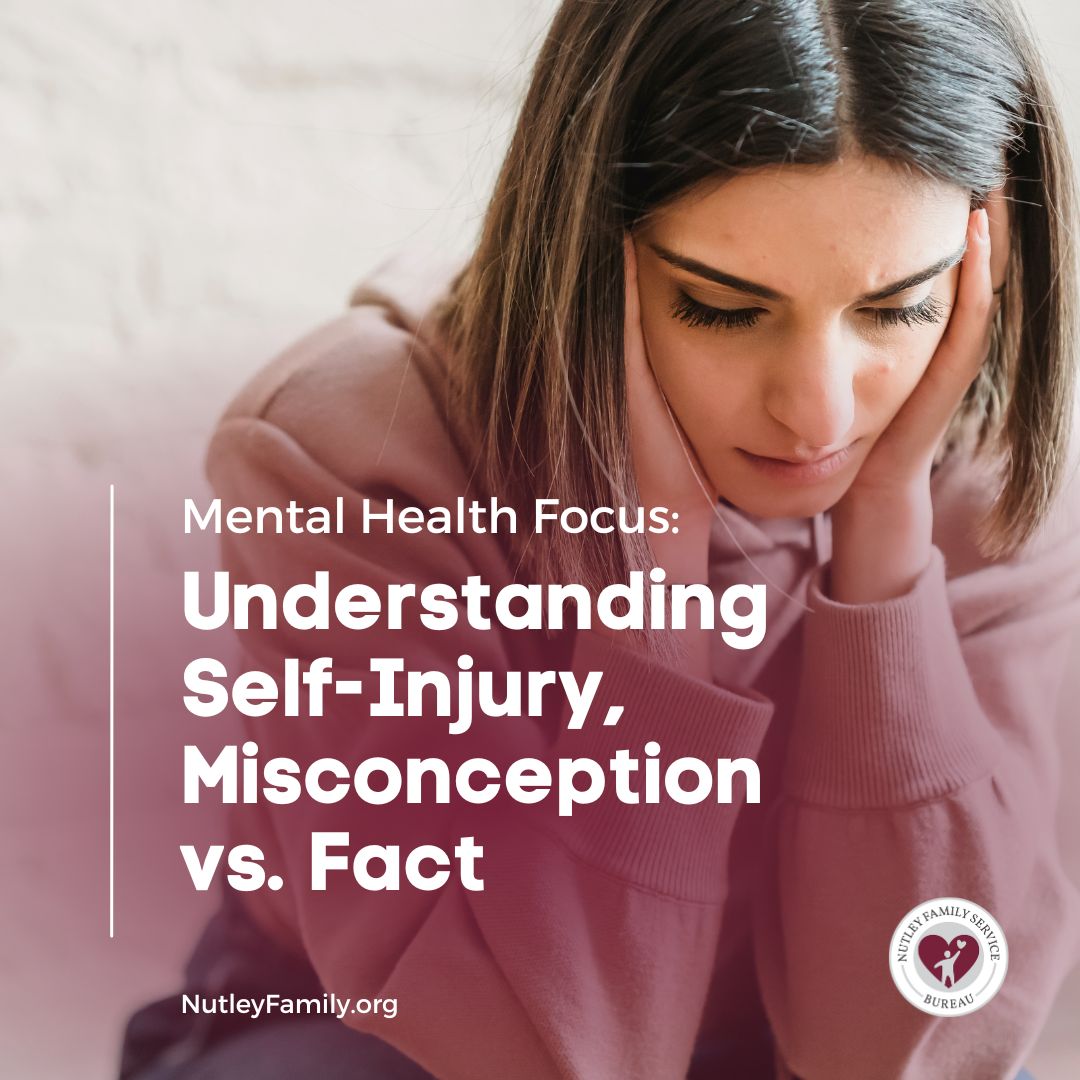-
Mental Health Focus: Understanding Self-Injury, Misconception vs. Fact
- Posted on February 27, 2024
- by admin
- in All Articles, Mental Health, NFSB Blog
- Comments Off on Mental Health Focus: Understanding Self-Injury, Misconception vs. Fact

The Mental Health Program at Nutley Family Service Bureau (NFSB) provides counseling and psychiatric services for individuals and families. New clients are welcome and immediate appointments are available. This article is part of an ongoing educational series focused on common mental health challenges, treatment techniques, and helpful tips.
When someone sees symptoms of self-injury, or self-harming behavior, in a loved one, they often jump to the worst-case scenario and assume the individual is suicidal. While this type of behavior indicates that something is not okay, it does not mean the person is trying to commit suicide.
Let’s discuss the definition of self-injury, common misconceptions, causes, symptoms, and how to support someone when you notice symptoms or the actual self-harming behavior.
What is self-injury?
Self-injury, or self-harm, is generally defined as the deliberate destruction or damage of one’s own body with one important caveat: there is no intent for this behavior to be lethal. Cutting is the most common form of self-injury. Others include burning, scratching, hitting, biting, hair pulling, and substance abuse.
What are common misconceptions about self-injury?
Self-injury can be a warning sign of an increased risk of suicide because it provides a window into how a person is feeling and coping with those feelings. However, as discussed at the beginning of this article, self-injury does not mean the person is attempting or planning to commit suicide.
“Sometimes self-injury is simply a way for someone to communicate how they’re feeling,” said Kelly Rivadeneyra, LCSW, Assistant Director of the Mental Health Center at NFSB. “This is often misunderstood and oversimplified as attention-seeking behavior when, in reality, they’re struggling to communicate that they’re not okay. Accusation or judgment of an individual that they’re just seeking attention can be very hurtful.”
What causes self-injury?
“Self-injury usually serves some sort of function for the individual,” Kelly said. “Research has shown that many people self-harm as a coping mechanism for managing intense emotions like pain, anger, shame, or emptiness. For others, self-injury serves as a means of gaining or regaining control over feelings that have overwhelmed them.”
In some cases, people reported what can be described as emotional numbness or a disassociated state. Self-injury helped them regain a certain level of feeling that had been missing. Self-injury can also be a way to punish oneself due to feelings of guilt, shame, or inadequacy.
What are the most common symptoms of self-injury?
While physical symptoms of self-harm can be visible, they can be hidden by hair, makeup, and clothing. Less obvious symptoms of self-injury include changes in eating or sleeping habits and a drop in academic or job performance.
“If you see that a person is consistently sad, down, or irritable, these can be symptoms of self-harming behavior,” Kelly said. “They tend to live in a negative space, sometimes in isolation. These are common symptoms for many conditions and, again, self-harm is not suicidal behavior, so it’s important that loved ones avoid overreacting.”
What should you do if you suspect a loved one is exhibiting self-harming behavior?
First and foremost, prioritize safety. If you happen to notice visible marks or wounds, encourage your loved one to seek medical attention. The second step is to pause and acknowledge how you feel.
“This is something that isn’t talked about enough,” Kelly said. “Loved ones often feel very uncomfortable, worried, confused, or angry. These feelings are appropriate, but they can lead to overreaction and panic. When you pause to acknowledge how you’re feeling, you can mitigate negative feelings before you approach your loved one.”
When discussing the possibility of self-injury, listening is essential. Focus on validating the feelings they’re expressing. Treating any condition as taboo tends to promote feelings of secrecy and shame, creating a negative ripple effect. Instead, focus on identifying patterns of self-injury by exploring how, when, and where they’re self-harming.
Finally, create a safety plan. Find out what tends to trigger a person struggling with self-injury. If a minor is involved, consider safety precautions, like removing sharp objects from the home.
Change is Possible!
Ideally, the individual would be open to seeking counseling and support from a professional counselor. The goal of counseling is to better understand what they’re experiencing, identify the underlying causes and triggers of self-injury, and learn how to challenge negative, distressing emotions. Family therapy can also improve communication and dynamics at home.
For a person struggling with self-harm, simply speaking to a loved one can be a coping mechanism. Exercise can release the “happy” chemicals that have a calming effect. Meditation, journaling, relaxation techniques, and even humor can help to mitigate uncomfortable feelings.
“The most important thing to remember is that this behavior can change,” Kelly said. “Self-harming behavior is treatable. Everyone has the power within them to manage stress and other negative emotions in a way that’s more positive and productive!”
If you or someone you know is engaging in self-harming behavior, we’re here to help. Schedule an appointment at NFSB. New clients are welcome and immediate appointments for mental health counseling are available. We’ll always respect your privacy. Call 973-667-1884 extension 1.
If you enjoyed this article please consider sharing it!

















